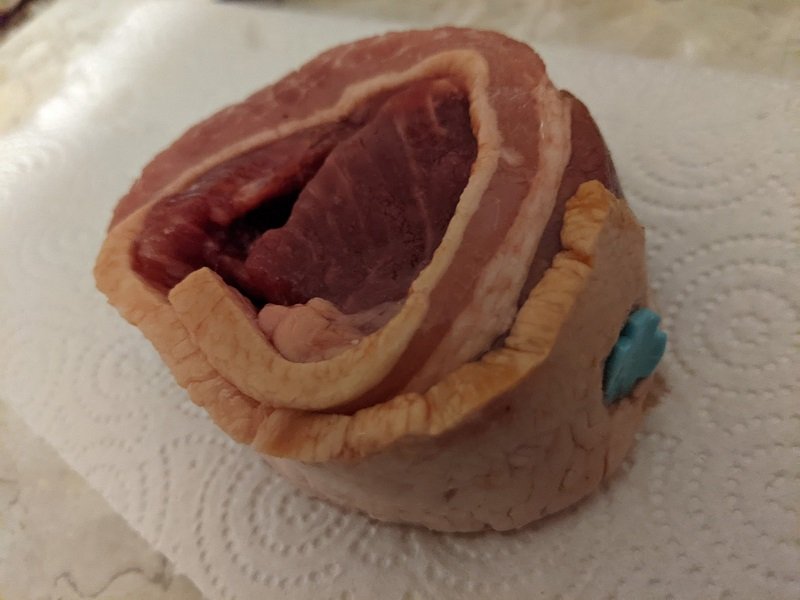The Taste Bud: What the Actual Hell is ‘Meat Glue’?
If you wrap it in bacon, it’s automatically filet mignon. Right? Photos by Kevin Gibson
I can’t recall the first time I saw or bought one of those prepackaged “filet mignon” steaks most grocery stores carry. I never knew what exactly they were, but I always suspected that they weren’t filet. Now I know and I sort of wish I didn’t.
They look nice, sitting there in their circular plastic packaging amongst all the other meat. I started buying them semi-regularly in recent years mostly because they’re cheap – usually around five bucks, which is proof it’s not really a filet mignon steak. But I also eat less red meat than I used to, so I rarely splurge on a big cut of ribeye or sirloin. Those “filets” are more of a “just-right” size for me these days.
But if you notice, they are hunks of meat wrapped in bacon, with a plastic skewer punched through them – and that skewer is another giveaway. Sure, it’s to keep the bacon in place, but it’s also partly to keep the steak itself together, if I guess correctly. Why do I say this? Because that so-called filet is actually several pieces of beef held together with a product often referred to as “meat glue.”
That’s right: MEAT GLUE.
The technical name of meat glue is actually transglutaminase, which is possibly even less appetizing if that’s possible, and according to TheKitchn.com, it is an enzyme created through the fermentation of bacteria. Here’s how TheKitchn describes its use: “It enables industrial meat producers and purveyors to take cheap chunks of beef, ‘glue’ them together, and create what looks like a pricey cut of meat.”
Or as Salon.com put it, “By liberally dusting meat pieces with transglutaminase powder, squishing them into filet mignon-shaped molds, adding a bit of pressure to bond the pieces and chilling them — voila, four-bucks-a-pound stew meat looks like a $25-a-pound filet mignon!”
Producers are supposed to identify the “filet” as “formed” or “reformed” meat. Again, not exactly appetizing.
Anyway, I had one in the freezer when my curiosity of what those “steaks” actually were made of got the best of me, and that’s when I stumbled upon the term “meat glue.” What did I do? I did what any red-blooded American male would do: I cooked the damn steak. And this time I paid attention to what I was eating.
You see, I had noticed a couple of times when cooking those pieces of meat that if you pull the skewer out before you cook it, the steak starts to sort of fall into two or three sections. That’s what made me suspicious and made me think that piece of blue plastic wasn’t just about the bacon.
But this time around, I left it in, which apparently is what’s supposed to happen. I coated both sides in spicy Dan-O’s seasoning and pan-seared it (very rare, as always, possibly too rare, but I didn’t die), but if you notice in the photo below, the “steak” began to separate as soon as I pulled it out of the plastic.
It seemed to pull together a bit with cooking, but if you study the cooked version, you can detect seams, which I assume is where the pieces of whatever kind of beef this is are “glued” together by tasty, tasty transglutaminase. Yum, yum!
Did it taste good? Well, yeah. I mean, it was wrapped in BACON, for goodness sake. But with the help of good old meat glue, one wonders what could be wrapped in a strip of thick bacon, skewered and called “filet mignon.” Spam? Chitterlings? Fruit Loops? Just glue it together, wrap it in bacon and BOOM, you’re living like the rich and famous.
Seriously, though, meat glue isn’t uncommon and it’s been around a while. If you eat lunch meat or hot dogs or chicken nuggets or even certain types of cheeses, well, you might be eating meat glue. The American Meat Institute reports about 8 million pounds of meat in the United States contain meat glue. In the U.S., more than 49 billion pounds of meat are consumed annually. That means about 0.016 percent of all the meat in Americans’ diet has the enzyme.
Hey, industrialization brought about all kinds of fun inventions.
It should be noted that in 2010, the European Union banned the use of transglutaminase, according to Food Safety News. That’s probably because it may or may not have connections to disease such as celiac disease and even Parkinson’s, according to some of the information I found. But the USDA, in all its wisdom, still allows it, with the FDA declaring meat glue as “generally recognized as safe.”
So, the next time you have a piece of meat, check to see if it is labeled as “formed” or “reformed.” Or see if it has “TZ enzyme” in the ingredients. If so? Bon appetit! Enjoy the glue.








